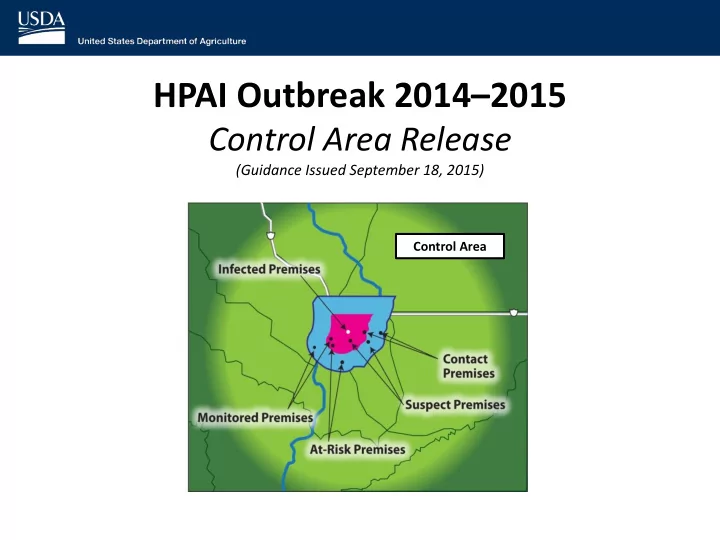

HPAI Outbreak 2014 – 2015 Control Area Release (Guidance Issued September 18, 2015) Control Area 1
Policy Update Provides responders with revised procedures learned from the 2014 – 2015 highly pathogenic avian influenza (HPAI) outbreak. Key Components Background Information General Guidance Timeline for Releasing Control Area & Associated Movement Restrictions Surveillance Information Regaining HPAI-Free Status 2
Background Information Release of the Control Area also relates to other HPAI response activities that are not covered in this document. For more information: On restocking approval, please see: Timeline, Eligibility, and Approval for Restocking . On environmental sampling, please see: Post Cleaning & Disinfection Environmental Sampling Guide. On designations used in an HPAI response, please see: HPAI Zones and Premises. These documents can be found at www.aphis.usda.gov/fadprep.
General Guidance Release of the Control Area (including the release of associated movement control and permit requirements) is allowed when the following conditions have been met: The last Infected Premises in the Control Area has been depopulated; either the compost pile has been started, mortality buried, or mortality removed from the premises for appropriate disposal. Initial cleaning and disinfection/virus elimination activities on the premises are completed (including, but not limited to, outside areas of premises, equipment, trucks, and other potential fomites used in depopulation activities). This does not include barn interiors. Required outbreak surveillance in the Control Area (commercial premises and backyard premises) has been completed; there is no evidence of HPAI infection in the Control Area. Surveillance requirements for international or bilateral trade are conducted and may continue. 4
General Guidance for Control Area Release (continued) If there have been no positive diagnostic results for HPAI in the Control Area for 21 days since the initial cleaning and disinfection of the last Infected Premises, AND the conditions in the previous slide have been met, the Control Area may be released. The Control Area may be released prior to the date in which restocking is allowed on the last Infected Premises. These requirements may be modified during an incident. 5
Timeline for Releasing Control Area & Associated Movement Restrictions The Control Area and associated movement control restrictions are maintained until at least 21 days have elapsed since the initial disinfection of the Infected Premises and negative results of all surveillance activities were obtained. The figure below shows a timeline for the release of the Control Area. 6
Surveillance Information For information on surveillance in the Control Area, please see the following (www.aphis.usda.gov/fadprep): Surveillance of Backyard Flocks Around Infected Premises. Surveillance Sampling for Commercial Premises in Control Area. International & Bilateral Trading Partners Enhanced surveillance for international and bilateral trading partners may be necessary both prior to and after the release of the Control Area. The extent, frequency, and type of enhanced surveillance required will depend on many factors, such as (but not limited to) the density of the poultry in the region, epidemiological information, species, and commodity exported. The objective of this surveillance is to provide evidence of the absence of HPAI infection to satisfy international and bilateral trading partners. Active and passive surveillance schemes may be used. 7
OIE Guidance, 2015 Terrestrial Animal Health Code 10.4.4 The OIE defines a country, zone, or compartment free from infection with HPAI viruses in poultry as follows: A country, zone, or compartment may be considered free from infection with HPAI in poultry when: 1. It has been shown that infection with HPAI viruses in poultry has not been present in the country, zone, or compartment for the past 12 months, although its status with respect to low pathogenicity avian influenza viruses may be unknown; or 2. When, based on surveillance in accordance with the article 10.4.27 to 10.4.33, it does not meet the criteria for freedom from avian influenza but any virus detected has not been identified as HPAI virus. The surveillance may need to be adapted to parts of the country or existing zones or compartments depending on historical or geographical factors, industry structure, population data, or proximity to recent outbreaks. If infection has occurred in poultry in a previously free country, the free status can be regained three months after a stamping-out policy (including disinfection of all affected establishments) is applied, providing that surveillance in accordance with Articles 10.4.27 to 10.4.33 has been carried out during that three month period. 8
Regaining HPAI-Free Status Through the OIE Surveillance for proof of disease freedom starts 21 days after depopulation of the last Infected Premises. – For more information on surveillance proof of disease freedom for both commercial and backyard premises in the Infected Zone, Buffer Zone, and Surveillance Zone, please see the HPAI Response Plan, Appendix D and the HPAI Surveillance SOP. While the World Organization for Animal Health (OIE) does not grant official recognition for freedom from notifiable avian influenza, including HPAI, the United States can self-declare freedom and submit all relevant documentation and evidence of freedom, per the OIE Terrestrial Animal Health Code, to the OIE in order to demonstrate freedom to trading partners. – Articles 10.4.27 and 10.4.33 of the 2015 Code provide broad information on surveillance and the interpretation of positive test results. As stated in Article 10.4.27, “The impact and epidemiology of avian influenza differ widely in different regions of the world and therefore it is impossible to provide specific recommendations for all situations. Surveillance strategies employed for demonstrating freedom from avian influenza at an acceptable level should be adapted to the local situation. ” 9
Recommend
More recommend